Tarja Halonen
Tarja Kaarina Halonen ([tɑrjɑ kɑːrinɑ hɑlonen] (![]()
President[1] Tarja Halonen | |
|---|---|
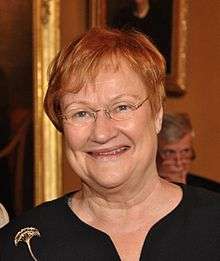 | |
| 11th President of Finland | |
| In office 1 March 2000 – 1 March 2012 | |
| Prime Minister | Paavo Lipponen Anneli Jäätteenmäki Matti Vanhanen Mari Kiviniemi Jyrki Katainen |
| Preceded by | Martti Ahtisaari |
| Succeeded by | Sauli Niinistö |
| Minister of Foreign Affairs | |
| In office 13 April 1995 – 25 February 2000 | |
| Prime Minister | Paavo Lipponen |
| Preceded by | Paavo Rantanen |
| Succeeded by | Erkki Tuomioja |
| Minister of Justice[2] | |
| In office 28 February 1990 – 26 April 1991 | |
| Prime Minister | Harri Holkeri |
| Preceded by | Matti Louekoski |
| Succeeded by | Hannele Pokka |
| Member of Parliament for Helsinki | |
| In office 24 March 1979 – 29 February 2000 | |
| Succeeded by | Ilkka Taipale[3] |
| Personal details | |
| Born | Tarja Kaarina Halonen 24 December 1943 Helsinki, Finland |
| Political party | Social Democratic Party |
| Spouse(s) | |
| Alma mater | University of Helsinki |
| Signature | |
| Website | Official website |
Halonen was an extremely popular president, with her approval ratings reaching a peak of 88 percent in December 2003. She was re-elected in 2006, defeating National Coalition Party candidate Sauli Niinistö in the second round by 51% to 48%. Ineligible to run in the 2012 presidential elections because of term limits, Halonen left office on 1 March 2012 and was succeeded by Niinistö.
Widely known for her interest in human rights issues, Halonen served as the chairperson of the Finnish LGBT rights organization Seta in the 1980s, and she actively participated in the discussion of issues such as women's rights and the problems of globalization during her presidency. In 2006, she was mentioned by various commentators as a potential candidate for the United Nations Secretary-General selection, but she denied an interest at that time, stating that she wanted to finish her term as president before thinking about other career options.[5][6] In 2009, Forbes named her among the 100 most powerful women in the world.[7]
Halonen is a member of the Council of Women World Leaders, an international network of current and former women presidents and prime ministers whose mission is to mobilize the highest-level women leaders globally for collective action on issues of critical importance to women and equitable development.
Early life and career
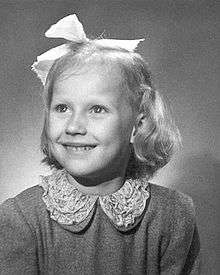
Tarja Halonen was born on 24 December 1943 in the district of Kallio which is a traditional working-class area in central Helsinki. Her mother Lyyli Elina Loimola was a set-dresser and her father Vieno Olavi Halonen worked as a welder. Halonen's parents married each other at the beginning of World War II and Tarja was born a few years later. Vieno Halonen was at the frontline and Lyyli Halonen was working in a shoe factory when their daughter was born. After the war the couple decided to get a divorce, and in 1950 Lyyli Halonen married her new husband Thure Forss, who worked as an electrician and was very active in the working-class community.
Both Halonen's mother and her stepfather influenced her world view extensively. Halonen later said that her mother was a true survivor, always an extremely active and resilient person who valued good, honest and modest hardworking people. When she entered politics, Halonen stated that these are also the qualities and attributes she respects in people.
In 1950 she began her studies in Kallio Elementary school from where she later moved to Kallio Gymnasium and finally finished her matriculation examination in 1962. She began to study Art History in the University of Helsinki in 1962 but in autumn 1963 she changed her studies to law, and obtained her Master of Laws degree in 1968 specializing in criminal law.
She began to work as a lawyer, already before obtaining her degree, in a credit surveillance company Luotonvalvonta oy in 1967. After working there for a few years, she was hired by the National Union of University Students in Finland to work as a Social Affairs and General Secretary from 1969 to 1970. Her work in the Union spurred her interest in politics, and in 1970 she obtained a post as a lawyer in the Central Organisation of Finnish Trade Unions, being the first female ever to work as a lawyer in the Union.
In 2012, Tarja Halonen joined the Nizami Ganjavi International Center Board, it is a cultural, non-profit, non-political organization dedicated to the memory of Persian poet, Nizami Ganjavi, the study and dissemination of his works, the promotion of the principles embodied in his writings, the advancement of culture and creative expression, and the promotion of learning, dialogue, tolerance and understanding between cultures and people.
Political career: 1970–2000
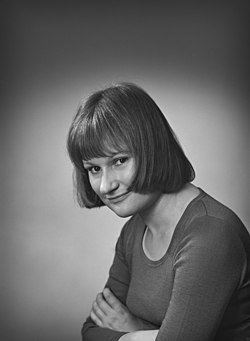
Trade unionist
In 1971 Halonen joined the Social Democratic Party which had close ties with the trade unions in which she worked as a lawyer from 1970 to 1974.
In early 1970 she was elected to represent Central Organisation of Finnish Trade Unions in a committee that called for the recognition of East Germany.[8] Later she became the Vice-President of the committee, which lobbied then-President Urho Kekkonen.[8][9] During the presidential elections of 2006 she was criticized by rivals for this.[10] She responded that the committee was formed by members from many different political parties including conservative parties. In 1973 Finland recognized both East Germany and West Germany as sovereign states.[11]
First elections
In 1974 Prime Minister Kalevi Sorsa appointed Halonen as his parliamentary secretary. She became acquainted with the world of Finnish politics and government and her political career took a great step forward, as she went on to hold a number of public offices. Sorsa later said that he wanted his parliamentary secretary to have good ties with the trade unions of Finland and have skills in jurisprudence.
Working in Parliament made Halonen even more interested in politics and she decided to take part in the municipal elections of 1976. She was elected to the City Council of Helsinki, a position she held continuously for five terms from 1977 to 1996. Additionally in 1979, she was elected into Parliament as a representative of the Helsinki constituency. She served five full terms and less than a year of her sixth term in Parliament until her inauguration as President in 2000. In Parliament, her first formal post was as the chairman of the Social Committee, which she held from 1984 to 1987.
Minister career
In 1987, Halonen was appointed Minister of Social Affairs and Health by Prime Minister Harri Holkeri. Halonen held the position until 1990. In addition to this, she served as Minister for Nordic Cooperation from 1989 to 1991, the same year in which she was also appointed the chairman of the International Solidarity Foundation, a post she relinquished in 2000.
From 1990 to 1991 she served as Minister of Justice, and from 1995 until her election to the presidency, she served as the Minister of Foreign Affairs in the Lipponen I Cabinet.[12][13]
2000 Presidential campaign
Halonen announced in 1999 that she wished to stand as a candidate for President in the 2000 presidential elections. In the preliminary elections of the Social Democrats Halonen ran against Pertti Paasio, a member of the European Parliament and former party chairman, and Jacob Söderman, the European Ombudsman. The incumbent, Martti Ahtisaari, refused to run in party preliminaries and thus announced that he would not run for a second term. Halonen won the preliminaries by a landslide, getting 7,800 out of 12,800 votes.
Halonen was a surprising candidate as she didn't represent many traditional values: she was known as a left-wing social democratic party member, who lived in a domestic partnership, was a single parent and had resigned from the national church. Despite starting from fourth place in the presidential election polls, in the first round of the elections, Halonen got the most votes, 40.0%. Her nearest opponent, former prime minister Esko Aho of the Centre Party, got 34.4%.
Since neither of the two candidates got over 50% of the votes, a second round was held. In the second round, Halonen narrowly defeated her opponent with 51.6% against 48.4%, thus becoming Finland's first female head of state. Her first term began on 1 March 2000.
First term in office: 2000–2006
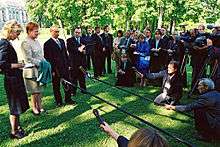
After her narrow election victory in the first election, Halonen's approval ratings rose and reached a peak of 88% in December 2003.
In a 2001 interview Halonen said that she was worried about the Russian response if NATO approved membership bids by Baltic countries.[14] Latvian President Vaira Vike-Freiberga asked what she meant and whether Halonen is actively opposing NATO membership of Baltic countries.[15]
In the Iraqgate scandal, Halonen's advisor Martti Manninen leaked confidential documents to the Centre Party leader Anneli Jäätteenmäki, who had become Prime Minister. The revelations led to the resignation of Jäätteenmäki.[16]
Halonen has opposed the use of landmines in Finnish military doctrine.[17]
Halonen has defended cluster bombs and did not sign a treaty which would have banned Finland from using these kinds of weapons.[18]
2006 Presidential campaign
On 20 May 2005, Halonen held a press conference in Mäntyniemi where she announced her willingness to run for a second term. Officially, this was the desired answer for the SDP delegation that had visited her two days earlier. In addition to her own party's support, the leader of the Left Alliance, Suvi-Anne Siimes, gave her support for Halonen's future campaign.
SAK openly lobbied for her re-election. It used its members' money on mudslinging campaigns on behalf of Halonen. In those flyers, "Niinistö is presented as the horror of worker, whereas SAK-supported Halonen is like a worker's dream". Halonen said she approved of the flyers.[19]
A study analyzed newspaper articles and concluded that the main newspaper Helsingin Sanomat produced almost exclusively positive tone stories about Halonen and much more negative tone articles about candidates Niinistö, Vanhanen and Hautala.[20]
American talk show host Conan O'Brien made recurring jokes about Halonen on his show, Late Night with Conan O'Brien, because of his own resemblance to her.[21] He endorsed Halonen and produced humorous mock campaign ads and attack ads against her opponents. He went as far as visiting Finland and meeting Halonen.[21]
On 19 November, the SDP's party council meeting was held; praised as "the president of the whole nation", she was unanimously chosen as the presidential candidate. Shortly thereafter, the party council of the Left Alliance gave the party's official support to Halonen.
Halonen's received 46% of the first round vote in the election. Sauli Niinistö (of the National Coalition Party) was second with 24%. They faced each other in a runoff on 29 January 2006, where Halonen was re-elected with 51.8% of the vote against Mr. Niinistö's 48.2%. The re-election was a close call. She led in the advance voting, but she eventually received fewer votes on the actual voting day than Mr. Niinistö did.
Second term in office: 2006–2012
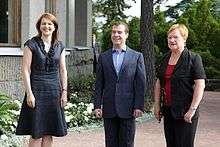
In 2008, Halonen nominated SDP-affiliated Ritva Viljanen for a second term in the Ministry of the Interior. The government had nominated Ilkka Laitinen. Over the course of the previous 50 years, the President had only once chosen to not obey the government's consensus, leading to Halonen thusly being accused of cronyism.[22][23]
In September 2008, Halonen was perceived as insulting Estonia by saying that the Estonians suffer from a "post-Soviet stress condition". President of Estonia Toomas Hendrik Ilves commented on the issue, saying that "Estonia has never condemned, and will not condemn the foreign affairs decisions of another EU country. It will also not assess the psychiatric state of other EU countries".[24][25] In 2009, Halonen rejected calls to apologize for Finland's attitude towards Estonian independence from the Soviet Union in 1991.[26]
At the end of her second term Halonen's presidency and economic views received harsh criticism from Björn Wahlroos, the chairman of the two largest banks in Finland.[27]
Political views
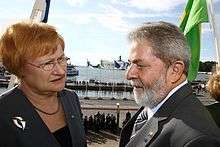
Early in her political career Halonen represented the far-left wing of the SDP. She publicly opposed the proposed free trade agreement of the European Economic Community in 1973, by signing a petition along with 500 other prominent social democrats and socialists. Otherwise she was loyal to President Kekkonen's foreign policy, which was founded on Finnish neutrality and good relations with the Soviet Union.
Throughout her political career, Halonen has described herself as a supporter of international solidarity. She describes herself as a "relative pacifist", meaning that she doesn't support unilateral disarmament. She has strongly defended the President's role as the commander in chief of the military.[28] She opposes NATO membership. Her strong stands on these issues have characterised her presidential term and shaped Finnish foreign policy, in part in cooperation with the like-minded former Minister of Foreign Affairs, Erkki Tuomioja.
Halonen has publicly supported the involvement of the Central Organisation of Finnish Trade Unions (SAK) in politics.[29]
The Constitution of Finland and Halonen's decision to take part in some European Union meetings with the Prime Minister has created the so-called "problem of two dinner plates" in Finland. Since most other countries only have their Prime Ministers representing them, it was also decided in Finland that the task is reserved for the Prime Minister in most cases.[30][31]
On 20 March 2013, Halonen publicly voiced her support for same-sex marriage.[32]
Personal life
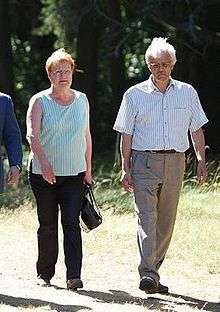
President Halonen says her interests include art history, the theatre and swimming. She says she speaks Finnish, Swedish, and English, and is studying Estonian.[33] Halonen had two cats during her presidential term. After they died, she was given a Neva Masquerade cat in 2013 by Russian prime minister Dmitry Medvedev.[34]
On 26 August 2000, President Halonen married her longtime partner, Dr. Pentti Arajärvi, in a civil ceremony at her official residence, Mäntyniemi, after a relationship of more than fifteen years. Halonen's adult daughter Anna, and Arajärvi's adult son Esko, acted as witnesses.[35] Both children are from previous relationships.
She promotes Finland in her personal accoutrements, such as wearing a Moomin watch.[36]
In the 1960s, she left the Evangelical Lutheran Church of Finland, to which the majority of Finns belong, to protest against its policy of taxing church members and its stance against female priests. Today, the church accepts women as priests and Halonen has stated that she has no personal reason not to return to the church but refrains from doing so in order not to give a signal that might be misinterpreted.[37] In the 1990s, Halonen acted as the chairman of Suomen setlementtiliitto, a Christian social work organization.[38] After her presidential term, Halonen rejoined the Evangelical-Lutheran Church. According to her statements, she had previously refrained from it as it might have been considered an attempt to garner political support.[39] Since then, Halonen has even preached publicly in a divine service of her home parish of Kallio.[40] This is a privilege that the parish priest may grant only in exceptional cases to persons known for their Christian conviction.[41]
In 1980–1981 Halonen served as the chairman of Seta, the main LGBT rights organization in Finland. When she became Minister of Justice in 1990, there were high hopes among Seta members that she would stand up for gay rights.[42]
According to her authorized biography published in 2005, Halonen is critical of some unnamed members of the Finnish civil service for being gay or lesbian and not coming out and campaigning for sexual equality. She accused these closeted homosexuals of reaping the benefits of other people's work for sexual equality without contributing themselves.
Positions
- Member of the Social Democratic Party 1971–2000
- Vice-President of the GDR Recognition Committee 1972–1973
- Prime Minister's Parliamentary Secretary 1974–1975
- Member of Helsinki City Council 1977–1996
- Member of Parliament (Helsinki constituency) 1979–2000
- Member of the Parliamentary Social Affairs Committee 1979–1986 (chair 1985–1986)
- Deputy member of the Parliamentary Commerce Committee 1979–1982
- Presidential elector 1979–1986
- Member of the Parliamentary Trustees of the Social Insurance Institution of Finland 1980–1984
- Deputy member, Parliamentary Foreign Affairs Committee 1982–1986
- Minister of Social Affairs and Health 1987–1990
- Minister of Nordic Cooperation 1989–1991
- Minister of Justice 1990–1991
- Member and vice chair of the Parliamentary Legal Affairs Committee 1991–1995
- Member of the Parliamentary Grand Committee 1993–1995 (chair 1995)
- Minister of Foreign Affairs 1995–2000
- President of Finland 2000–2012
Criticism
Halonen voiced sexist views when commenting on how the Covid-19-pandemic was handled in different countries.[43]
Honours and awards
| Coat of Arms of Tarja Halonen | |
|---|---|
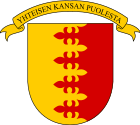 | |
| Armiger | Tarja Halonen |
| Adopted | 2001 |
| Motto | "Yhteisen kansan puolesta"("For a united nation") |
Honours
National honours



Foreign honours

.svg.png)











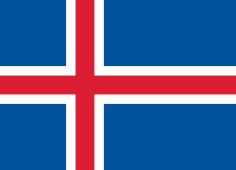




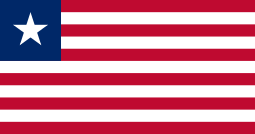

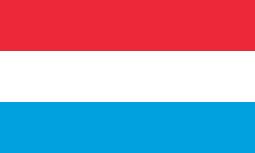








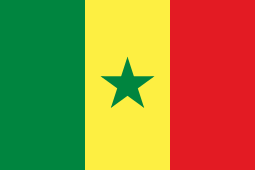






Awards








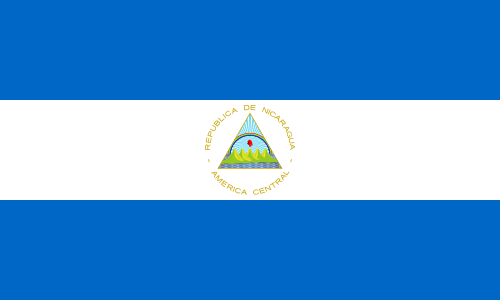








In popular culture
A long-running joke, which stems from the recurring segment "Conan O'Brien Hates My Homeland", is that American talk show host Conan O'Brien resembles Tarja Halonen. After joking about this for several months (which led to his endorsement of her campaign), O'Brien travelled to Finland, appeared on several television shows and met President Halonen.[69] The trip was filmed and aired as a special.[70]
See also
- List of national leaders
- Club of Rome
References
- Courtesy title in Finland for former Presidents of the Republic
- "Council of State – Ministers of Justice". Valtioneuvosto.fi. Retrieved 27 December 2017.
- Eduskunta – edustajamatrikkeli Archived 23 May 2013 at the Wayback Machine
- Skard, Torild (2014) "Finland's three national leaders" in Women of power – half a century of female presidents and prime ministers worldwide, Bristol: Policy Press, ISBN 978-1-44731-578-0
- "Candidates". United Nations. 2006.
- "The Next United Nations Secretary-General: Time for a Woman". Equality Now. November 2005. Archived from the original on 25 November 2007. Retrieved 24 November 2007.
- "The 100 Most Powerful Women". Forbes.com. 19 August 2009.
- Halonen toimi DDR:n hyväksi luultua aktiivisemmin at the Wayback Machine (archived 15 September 2007) from the original Aamulehti
- "HS – Sisäänkirjautuminen". 13 February 2013. Archived from the original on 13 February 2013. Retrieved 28 May 2018.
- DDR:n varjo vielä valaisematta. Turun Sanomat
- Professor says allegations of President Halonen’s GDR activism are untrue Helsingin Sanomat, 13 September 2007 Archived 22 October 2012 at the Wayback Machine
- "Ministry for Foreign Affairs of Finland – Ministers of Foreign Affairs". Valtioneuvosto.fi. Archived from the original on 14 February 2012. Retrieved 30 January 2018.
- "Ministerikortisto". Valtioneuvosto.
- Halonen: Baltian maiden liittyminen Natoon epäilyttää. MTV3. 8 April 2001
- Halosen Nato-lausunnoista kohu. MTV3. 7 May 2001
- Book on Iraq leak scandal: Manninen leaked secret documents out of job frustration Archived 20 October 2012 at the Wayback Machine
- Halonen criticised as global do-gooder; PM Vanhanen comes to President’s defence Archived 20 October 2012 at the Wayback Machine
- "Halonen puolustaa rypälepommeja: "Suomella ei ole mahdollisuuksia"". Retrieved 28 May 2018.
- "Niinistö kiistää SAK:n syytökset". Archived from the original on 12 June 2011. Retrieved 21 June 2009.
- Halonen, Halonen, Halonen – Onko presidentti valtamedian erityissuosiossa?. City
- "Conan O'Brien meets with Finnish leader". USA Today. Associated Press. 14 February 2006. Retrieved 27 August 2009.
- Halonen nimitti Viljasen sisäministeriön kansliapäälliköksi Archived 20 October 2012 at the Wayback Machine
- "Uutiset – Ilta-Sanomat". Ilta-Sanomat. Retrieved 28 May 2018.
- Halonen suututti virolaiset Archived 18 February 2012 at the Wayback Machine
- Yle: Halosen lausunto kuohuttaa Virossa Archived 16 July 2011 at the Wayback Machine
- Tarja Halonen: "En lämpene kollektiivisille anteeksipyynnöille". Suomen Kuvalehti
- Ahtiainen, Ilkka; Blåfield, Antti (12 February 2012). "Björn Wahlroos – a portrait of a capitalist". HS.fi International Edition. Sanoma. Archived from the original on 19 February 2012. Retrieved 19 February 2012.
- Anna Perho (2005): Tarja Halonen – ensimmäinen nainen Archived 18 October 2009 at the Wayback Machine City-lehti 24/2005
- Halonen puolustaa SAK:n roolia vaaleissa
- One foreign policy or two?. Tuomas Forsberg
- Finland's Halonen plays down dark clouds over two-plate policy. Helsinki Times
- "Halonen vetosi tasa-arvoisen avioliittolain puolesta" (in Finnish). MTV3. Suomen Tietotoimisto. 20 March 2013. Retrieved 26 March 2013.
- Office of the President of the Republic of Finland (2008). "President of the Republic Tarja Halonen answers children's questions". The President of Finland official site. Retrieved 2 August 2008.
- Ilta-Sanomat (2013). "Halosen kissa sai nimekseen Meggi: Se on kiltti ja utelias". Retrieved 7 August 2017.
- "The President of the Republic of Finland: Press Releases and News". www.presidentti.fi. Retrieved 15 April 2020.
- Cord, David J. (2012). Mohamed 2.0. Helsingfors: Schildts & Söderströms. p. 155. ISBN 978-951-52-2898-7.
- Interview of Halonen in Kotimaa 12 February 2005. Archived 30 October 2007 at the Wayback Machine On the official webpage of the president. Retrieved 10 October 2007. (in Finnish)
- Tarja Halosen setlementtiliike. Palkkatyöläinen 3/2000. Retrieved 10 October 2007. (in Finnish)
- HS: Näistä syistä Halonen erosi kirkosta – ja tämän takia hän liittyi takaisin. Iltalehti 2 March 2013. Retrieved 2016-02-03. (in Finnish)
- Presidentti Tarja Halonen saarnasi työttömyydestä Kalliossa. Yle 28 November 2013. Retrieved from 2016-02-17. (in Finnish)
- Kirkkojärjestys, Ch 2, Section 6. (The by-law of the Evangelical Lutheran Church of Finland). Finlex. Retrieved 17 February 2016. (in Finnish)
- "Tarja Halonen & SETA". helsinki.fi. Retrieved 28 May 2018.
- "Ex-President Halonen faces criticism for coronavirus-related radio remark". www.helsinkitimes.fi. Retrieved 10 August 2020.
- "Reply to a parliamentary question about the Decoration of Honour" (PDF) (in German). p. 1923. Retrieved 13 January 2013.
- http://c7.alamy.com/comp/GYHTWP/belgiums-queen-paola-1stl-and-king-albert-ii-1str-surround-finlands-GYHTWP.jpg
- "Modtagere af danske dekorationer". kongehuset.dk (in Danish). Retrieved 5 May 2019.
- http://c7.alamy.com/comp/GPNCPT/finlands-president-tarja-halonen-l-arrives-with-her-husband-pentti-GPNCPT.jpg
- http://media.gettyimages.com/photos/danish-prince-consort-henrik-delivers-a-speech-marking-the-40th-of-picture-id137115795
- "Archived copy". Archived from the original on 8 October 2016. Retrieved 8 January 2017.CS1 maint: archived copy as title (link)
- Estonian Presidency Website, Tarja Halonen
- Estonian Presidency Website, Tarja Halonen
- Estonian Presidency Website, Tarja Halonen
- "Archived copy". Archived from the original on 8 January 2017. Retrieved 8 January 2017.CS1 maint: archived copy as title (link)
- Icelandese Presidency Website Archived 5 July 2013 at the Wayback Machine
- "Елбасы Финляндияның жоғары ордендерімен марапатталды". ontustik.gov.kz (in Kazakh). 25 March 2009. Archived from the original on 20 December 2014. Retrieved 20 December 2014.
- "Archived copy". Archived from the original on 8 January 2017. Retrieved 8 January 2017.CS1 maint: archived copy as title (link)
- Lithuanian Presidency Archived 19 April 2014 at the Wayback Machine, Lithuanian Orders searching form
- http://c7.alamy.com/comp/D4HBEJ/finnish-president-tarja-halonen-r-toasts-with-grand-duchess-maria-D4HBEJ.jpg
- http://c7.alamy.com/comp/D4HBDN/r-l-grand-duke-henri-of-luxembourg-finnish-president-tarja-halonen-D4HBDN.jpg
- http://c7.alamy.com/comp/GYDDMR/the-wedding-party-of-norways-crown-prince-haakon-and-his-newlywed-GYDDMR.jpg
- Kremlin
- Slovak republic website, State honours Archived 13 April 2016 at the Wayback Machine : 1st Class received in 2005 (click on "Holders of the Order of the 1st Class White Double Cross" to see the holders' table)
- "President of the Republic of Slovenia > Slovenian President on a state visit to Finland". www2.gov.si. Retrieved 28 May 2018.
- http://www2.gov.si/up-rs/2007-2012/turk-ang-arhiv.nsf/0/F74EB004AF4672BFC12576E300538F79/$File/V_2010-03-09_DRŽAVNIŠKI-OBISK-FINSKA-7_STA.JPG
- Boletín Oficial del EStado
- http://c7.alamy.com/comp/D59DDC/finlands-president-tarja-halonen-l-and-husband-pentti-arajaervi-arrive-D59DDC.jpg
- http://cbsnews3.cbsistatic.com/hub/i/r/2006/05/01/4c3831c6-a642-11e2-a3f0-029118418759/resize/620x465/d962ad29bf7d5b1166aa12c02e2e6588/image1568682.jpg
- http://static1.purepeople.com/articles/5/23/13/5/@/159131-la-reine-silvia-de-suede-la-950x0-2.jpg
- "Conan O'Brien meets with Finnish leader". USA Today. Associated Press. 14 February 2006. Retrieved 9 April 2013.
- Barish, Mike (26 January 2010). "5 places Conan should go on vacation". CNN. Retrieved 26 January 2010.
Notes
- For outstanding contribution to the development of a full, good and friendly between the Republic of Croatia and the Republic of Finland – 7 April 2009.
External links
| Wikimedia Commons has media related to Tarja Halonen. |
| Wikiquote has quotations related to: Tarja Halonen |
| Political offices | ||
|---|---|---|
| Preceded by Matti Louekoski |
Minister of Justice 1990–1991 |
Succeeded by Hannele Pokka |
| Preceded by Paavo Rantanen |
Minister of Foreign Affairs 1995–2000 |
Succeeded by Erkki Tuomioja |
| Preceded by Martti Ahtisaari |
President of Finland 2000–2012 |
Succeeded by Sauli Niinistö |
| Diplomatic posts | ||
| Preceded by Mary Robinson |
Chair of the Council of Women World Leaders 2009–2014 |
Succeeded by Dalia Grybauskaitė |